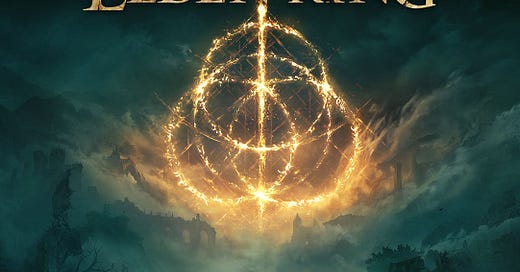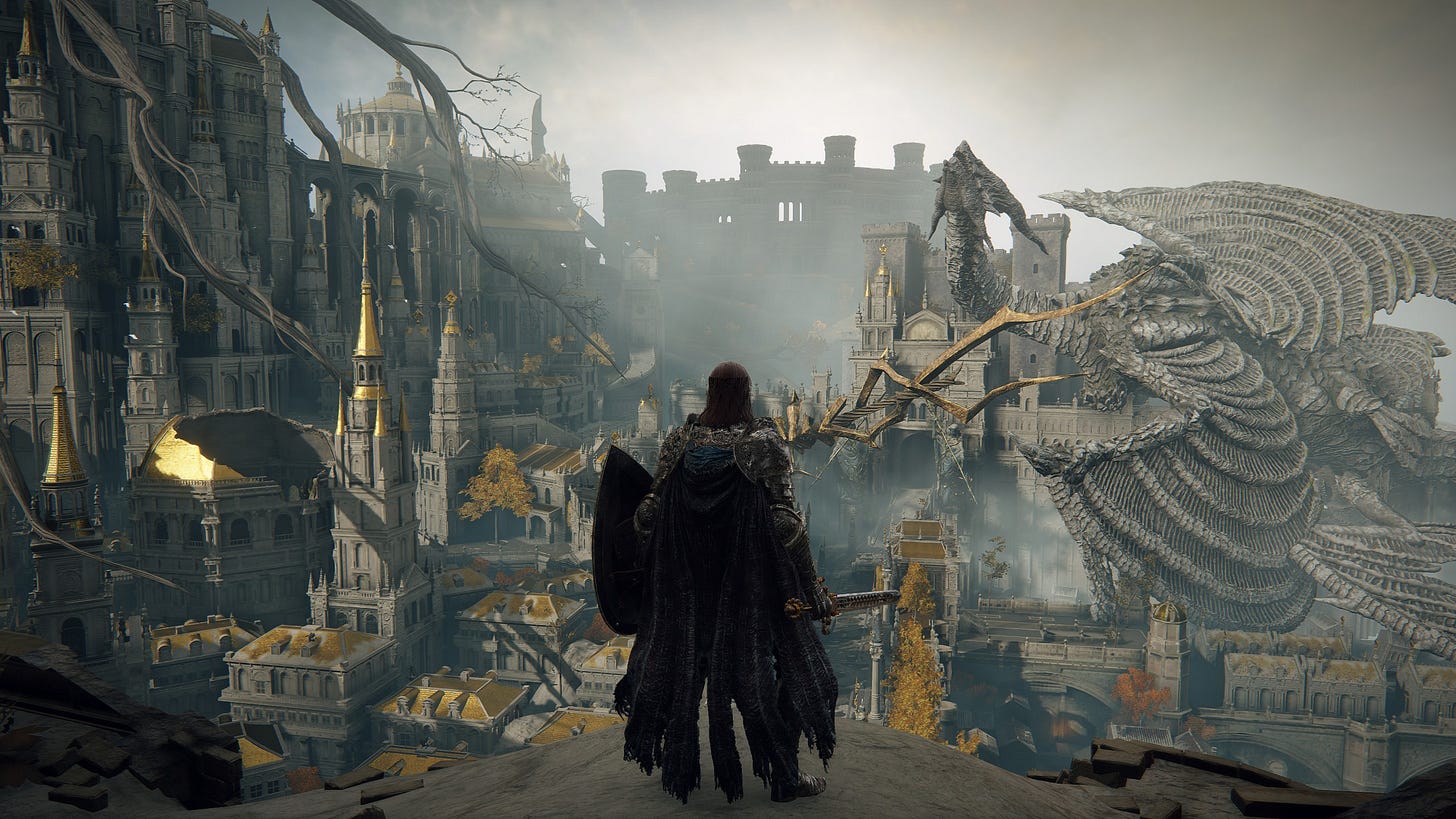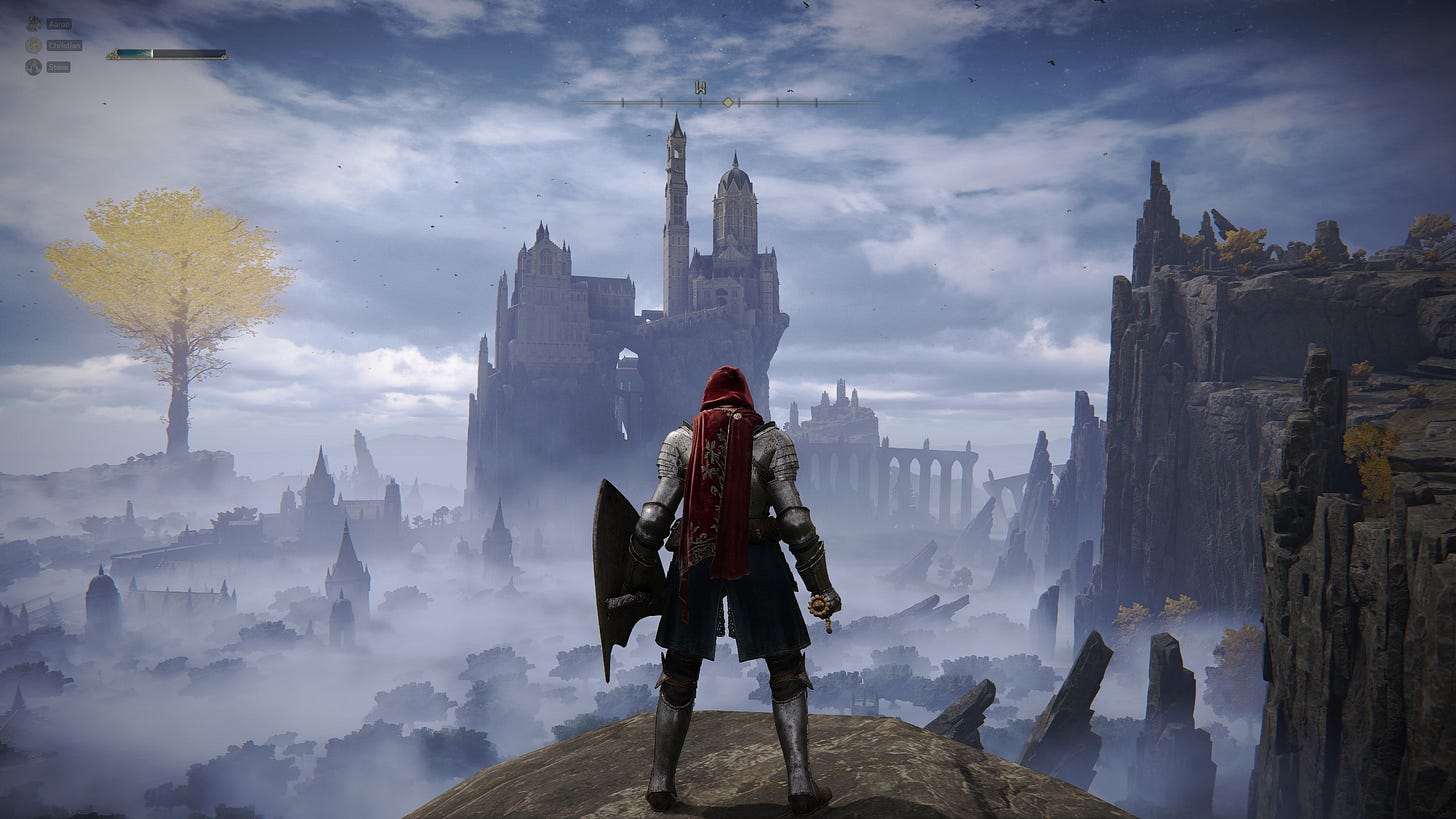For a long time, I did not have strong feelings about Elden Ring. It probably goes for a lot of games developed by FromSoftware. Led by one of the industry’s genuine visionaries, Hidetaka Miyazaki, the studio is best known for the Dark Souls franchise. It’s somewhat difficult to avoid hearing about the company, or its games, and many developers, especially “Indie” ones are strongly influenced by Miyazaki’s works. It’s for good reason: FromSoftware constructs narratives that utilize the unique language of gaming. Sadly, every time I play these games though, I find myself attempting to drive my head through a wall. Between the difficulty, oblique design choices, and an occasional “challenging” community, I found Elden Ring to be just another FromSoftware game.
Since its release in February of 2022, Elden Ring has been lauded as one of the greatest games of all time. It swept numerous “Game of the Year '' awards, and it’s not uncommon for people to cite it as a point of comparison. The release of its first DLC Shadow of the Erdtree continued these discussions, and sparked a fleeting desire of mine to go back and try the game at least one more time. And while I still have my reservations about the game, I think I am a little closer to “getting it.”
Each artistic medium has its own language. Authors use words. Film directors use sets, actors, and scenes. Painters use…well, paint. Game developers, for the most part, are still working to define this language. Miyazaki and the team at FromSoftware are, in many respects, amongst the leaders in doing that and have crafted a fair amount of stories that fully utilize the unique language that is available to video games. The reasons that I often critiqued these games in passing discussions with friends are ironically the very reasons that FromSoftware’s work can be cited to elevate games into artistic works: there are elements of language the game uses to craft its own narrative.
Every game in FromSoftware’s library shares a lot of “DNA”: they are notoriously difficult, purposefully vague in its storytelling, and demand a lot from the player in order to understand the mechanics, story and world. However, this comes together to “tell” the narrative in decidedly nuanced ways. FromSoftware puts a lot of energy into environmental storytelling, with elaborate dungeons and setpieces to lay the foundation for their settings. Every item in the player’s inventory has lore and a role to play in the world building. Characters and NPCs, while occasionally speaking in obscure riddles, share small tidbits of information that a studious player can patch together to craft a larger narrative. There is no sitting back and having the story being spoon fed to you. If you want the story, you are interacting with the game. But that’s something only games can do.
Due the consistencies in which FromSoftware tells their narratives, there is also a constancy within the themes across their games. To condense these themes into a few buzzwords would be a disservice, but for the sake of brevity: liminality. Liminality is a fancy word for being in a state of “ambiguity” or “disorientation.” Basically, things are unclear or uncertain. Being a teenager, for example, can be considered being in a “liminal” state, as one is not considered an adult, but one is also not a “kid” anymore. Nearly all of FromSoftware’s games explore a liminal state, and tackle very fundamental philosophical ideas as a result. The Dark Souls trilogy explores a space between life and death, the duality between light and darkness, and the cyclical nature of time. Bloodborne explores an uncertain space relating to humanity and evolution, and the desire to become “more” than just what we are. Sekiro also explores the liminal space between life and death, but with a twist on the nature of mortality, and the existential purpose of “death.” Regardless of the liminal space, there is a constant, although a bleak (and usually metaphorical) one: death. All of the games, in their own ways, validate death as an integral part of the human experience. This may explain why Miyazaki has said his games need to be challenging and that death is a “feature” built around that “death” can teach lessons.This circles back a central idea of gaming as an art form: the harmony between gameplay and narrative. All the thematic resonance in FromSoftware’s games come back to death in some way. The games are hard. The player will die. But there is a lesson in all of this. Death has “meaning” and all of FromSoftware’s games somehow address this.
It gets a little more complicated with Elden Ring. The game is more open ended, and asks as many questions as it provides answers. The player assumes the role of a “Tarnished”, which is, for the sake of simplicity, an immortal being in a world called “The Lands Between.” In other words, you are a liminal character in a very liminal space. The world and its beings reset whenever the character dies or takes a rest, meaning that nearly everyone is trapped in a perpetual cycle.
In terms of gameplay, this is somewhat convenient. The player can effectively travel and do things at their own pace. In fact, the game effectively remains in an effectively static state unless your character does something to incite some change. The convenience coincides well with the larger narrative, creating lasting thematic resonance. “The Lands Between” is intentionally this way as “destined death” is little more than a myth. With death becoming a lost concept, characters scattered about the world struggle to find purpose, hearkening back to the central thesis looming over all of FromSoftware’s games. Many of the smaller stories in Elden Ring reinforce this constant search for purpose. Players will meet many “lost souls” (if one will humor the term) as they search for their humanity or purpose or both in a land that unintentionally makes it increasingly difficult. Since the world is liminal, the people inevitably will be liminal too.
As an open world game, players are encouraged to explore “The Lands Between” throughout their experience. In addition to the aforementioned smaller stories, players will discover small dungeons, interesting locations, and isolated moments (both beautiful and horrifying). This trickling effect educates players about the world itself, its history and lore, and its people as players carve out their own understanding of what it means to be a Tarnished and the one person can determine what will be the ultimate fate of “The Lands Between.” Effectively, as the one person who can affect the world, we will determine our own purpose through the gameplay.
This comes back to the central narrative of the game, and the player’s journey to find the titular “Elden Ring.” Without spoiling too much, the “Elden Ring” is effectively a macguffin that dictates who becomes “The Elden Lord” that guides the larger fate of “The Lands Between.” Various characters are in conflict with this concept, with some upholding the divine laws around this edict and others who aspire to upend the entire idea. Subsequently, the player’s choices at the end of the game will ultimately answer which way is going to be the way of things, with the player’s larger journey will largely inform the ultimate decision that is made. In the midst of this, however, is a thread commenting on the nature of ambition. Every major character in the game that aspires to become “Elden Lord” has a vision for what they would do with that power, yet few are successful in acting on their ambitions. The game suggests their failures can be attributed to their very actions, or that the world’s stagnancy is too difficult to move or change. It’s a complex idea, and difficult to capture in so many words. But that is perhaps the merit to this larger theme of ambition. Ambition is what can guide us, but it is also what can destroy us.
I think that’s why some people latch on to Elden Ring with so much passion. It’s a game that understands it is a game first. Its story, characters, and gameplay all come together with so much cohesion that it's surprisingly difficult to unwrap in so many words with only so much time. But its use of liminal spaces to present a persistent world that you can change with your pure agency is enduring, and allows for a game to genuinely explore prominent themes that cannot be explored in any other way. That’s something truly special.





